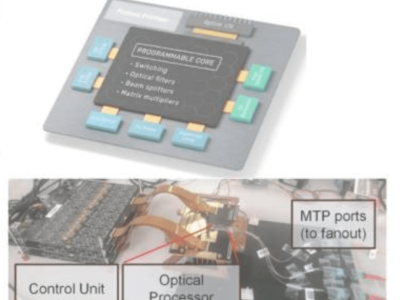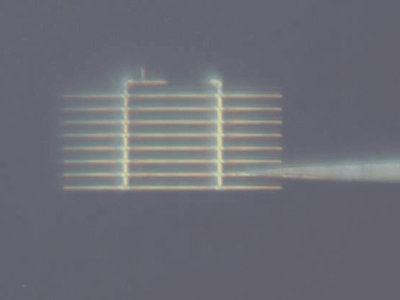
Cheap flexible sensor detects magnetic fields down to 20nT
In a paper titled “Highly compliant planar Hall effect sensor with sub 200 nT sensitivity” published in Nature’s npj Flexible Electronics journal, the researchers describe a very simple fabrication process, whereby assymetrical Permalloy (Py) Hall crosses just 20nm thick are patterned on 6µm-thick PET foils before being magnetized through multiple magnetic field sweeps (between ±3 mT).

The Hall cross described in the paper, occupying an area of about 400×400µm2, has a high aspect ratio of 10:1. This induces a preferred magnetization axis of the Py structure by shape anisotropy, further facilitated by one of the stripes being elliptically-shaped instead of rectangular. Four electrical contacts complete the device, sensitive mostly to the fields applied parallel to its elliptical axis.

showing the elliptical stripe.
Testing the flexible PHE sensor under various bending radii, the researchers report a resistance variation of only 0.3% after more than 150 bending cycles, and a maximum sensitivity of 0.86 V/T in the linear range of ±50 µT, making these sensors sensitive to magnetic fields down to 20nT, on par with state of the art values reported for rigid sensors. Even when bent to 1mm, the sensors still exhibited a high sensitivity of 0.63 V/T, the paper reports.

The authors anticipate that such flexible and easy to manufacture magnetic field sensors could be used to detect magnetic functionalized objects flowing in a fluidic channel (when wrapped around it), to detect the stray magnetic field generated by a current-carrying wire. As a proof-of-concept, they used the tiny sensors to measure the magnetic field generated by a pulsing DC current in a 2mm diameter insulated stranded copper wire. They were able to measure the magnetic field on the surface of the wire (running a 100mA DC current through it) at just about 20µT, concluding that their flexible PHE sensors offer a performance at least 10 times better than that of conventional bulky and rigid clamp meters used for current sensing today.
What’s more, the new sensors can be used to detect magnetic fields at an angle, as their output exhibits an angular dependence with the relative orientation of the magnetization with respect to the biasing current. This means the devices could be used as an angular sensor to provide orientation information in soft robotics applications.
 If you enjoyed this article, you will like the following ones: don't miss them by subscribing to :
eeNews on Google News
If you enjoyed this article, you will like the following ones: don't miss them by subscribing to :
eeNews on Google News



